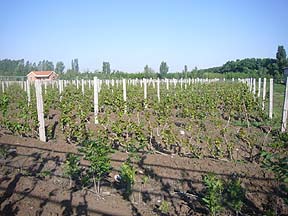
By Li Demei
–
While many people are aware that China produces a great deal of wine, few know about the challenges facing grape growers and wine makers in different parts of the country. Here is one pro and one con for each of the main wine regions.
Northwest (Xinjiang, Ningxia, and Gansu)
Pro: Summers tend to be hot and dry, so the grapes have higher sugar content and fewer problems with disease than in coastal regions, though they sometimes lack acidity.
Con: Winters are extremely cold, thus even burying the vines may not stop a relatively high percentage of them from being destroyed.
Northeast (Jilin)
Pro: Most grape varieties here are local (species: vitis amurensis) and resistant to the cold, even more so than the North American varietals.
Con: Growing seasons are too short and winters too cold to support vitis vinifera grapes, such as Merlot or Riesling.
North (Shanxi , Huailai and Changli in northeast Hebei)
Pro: Summers are dry and winters are warmer than in Xinjiang, thus while the vines have to be buried here, they are much more likely to survive.
Con: This area sees much more rain in some years than in others, thus disease can be a problem.
North (Beijing-Tianjin corridor)
Pro: This area is close to major markets.
Con: The soil and climate in these relatively flat areas is not good enough for growing quality grapes.
East coast (Shandong)
Pro: The relatively long wine-making tradition here means a greater supply of experienced employees. And unlike in the north, burying vines is not necessary in winter.
Con: Unlike in Mediterranean climates, which tend to experience separate hot and humid periods, this area gets them simultaneously, which means a lot of pesticides are needed to deal with the ensuing diseases.
Henan (Yellow River Valley)
Pro: Like Shandong, winters are warmer and burying the vines is not necessary.
Con: Summers are too hot and humid, and the issue of disease is greater here than in any other major grape-growing region of China.
Southwest (Yunnan)
Pro: The growing season is quite long, so much so that there is potential for two harvests.
Con: Harvest overlaps the rainy season. This could be solved by delaying the growing season – such as by pruning later – and thus utilizing the dry sunny weather that follows the rainy season.
–
Note: There are also other provinces with small plantings, ranging from Shaanxi and Szechuan with vitis vinifera grapes to Guangxi and Hunan with local grapes.

Sign up for the Grape Wall newsletter here. Follow Grape Wall on LinkedIn, Instagram, Facebook and Twitter. And see my sibling sites World Marselan Day, World Baijiu Day and Beijing Boyce. Grape Wall has no advertisers, so if you find the content useful, please help cover the costs via PayPal, WeChat or Alipay. Contact Grape Wall via grapewallofchina (at) gmail.com.
these problems are coming up due to the geographical position of the growing sites but is there a possibility for grapes to grow on a mountainous landscape provided the soils can support them and the climate is favourable eg places like bundibugyo in western Uganda